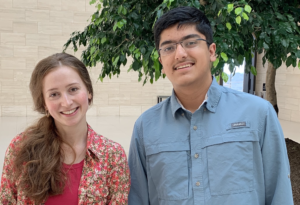by Buck Institute
August 16, 2019 . BLOG
Cellular Senescence: A Contradictory Condition
By Advait Thaploo, High School Summer Scholar in the Verdin lab
 I am Advait Thaploo, a junior at Mira Loma High School, and over the summer I worked here at the Buck Institute as a Summer Scholar. I worked in the Verdin Lab under my mentor, Dr. Olga Bielska, and I studied a novel regulator of an aging-associated process called cellular senescence. I have gained a deep interest for research on aging on top of my passion for environmental innovation. My other areas of interest are robotics, debate, and rowing.
I am Advait Thaploo, a junior at Mira Loma High School, and over the summer I worked here at the Buck Institute as a Summer Scholar. I worked in the Verdin Lab under my mentor, Dr. Olga Bielska, and I studied a novel regulator of an aging-associated process called cellular senescence. I have gained a deep interest for research on aging on top of my passion for environmental innovation. My other areas of interest are robotics, debate, and rowing.
Until recent years, many scientists had postulated that aging was an unavoidable constant of life. What’s more, at the cellular level, the mechanism of aging was still not understood. However, beginning in the mid 20th century, this began to change. The discovery of a new and exciting area of aging research, cellular senescence, has created a veritable ocean of research that helps us understand what happens to cells as they age.
The term senescence on its own is simply defined as “the process of aging.” More specifically, cellular senescence is the state in which a cell can no longer divide and create new cells. Scientists believe that senescence evolved as an anti-tumor mechanism—if cells start to express traits of cancerous cells, they may undergo senescence in order to prevent uncontrolled replication. However, this function comes with a downside. Senescent cells secrete a set of molecules known as the SASP (Senescence Associate Secretory Phenotype) which has been shown to be potentially harmful for surrounding cells. Surprisingly, the SASP can contain components that can spur unrestrained cell growth and damage cell structure. These are features that have been shown to promote the development of cancer. So rather than preventing tumors, senescent cells may actually cause them! Furthermore, as aging occurs, the body’s mechanisms that are supposed to remove these non-proliferating cells begin to degrade, and the senescent cells accumulate.
But luckily, the future of senescence research does not look so bleak. Scientists have been able to develop anti-senescence therapies in order to increase the healthspan of aging patients. The telomere, found at the ends of genes, is of particular importance because it protects DNA from deterioration. This is because every time DNA replicates, the telomere shortens incrementally. Once the telomere is no longer at a safe length, the cell is no longer able to proliferate and it may become senescent. Studies in mice observing increased levels of a telomere-lengthening enzyme called telomerase have shown signs of improvements in the health of the mice. Over time, it is likely that new treatments will become more prevalent and widely accessible to the public.
The complexity of the body’s immune system is fascinating, and this summer, I chose to work on a research project that demonstrated that various dysfunctional genes may cause atypical types of senescence. These forms of senescence differ in their SASP and other traits as opposed to the classical representation of senescence. By using a human cell line deficient in a certain protein, I was able to identify certain markers and traits that pointed towards the presence of a newly discovered form of senescence. This goes to show that senescence is highly diverse and may arise from an array of factors. My findings show that more research is necessary in order to understand the relationship between defective genes and recently discovered and unprecedented forms of senescence.
While we sometimes may feel like aging is a process that is inevitable, there are many steps that are being taken to understand how to slow it down at the cellular level. The fundamental causes for aging become clear once we understand how senescent cells affect other cells in the context of the human body. Therapies that may eventually limit the overproduction of senescent cells are starting to emerge, and that bodes well for the health of an aging population.

SHARE